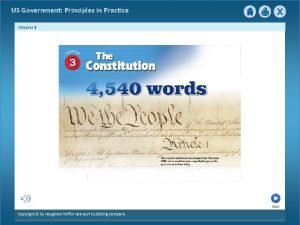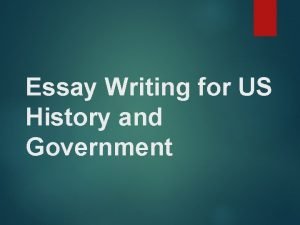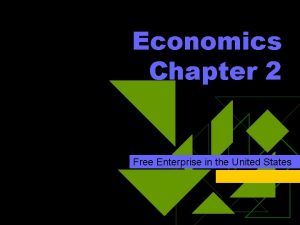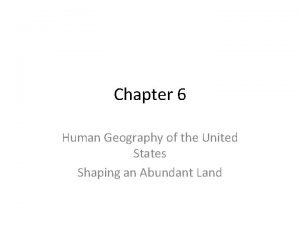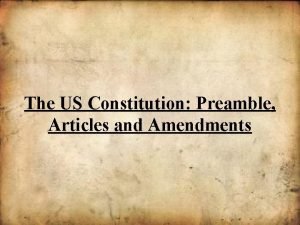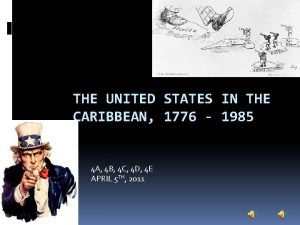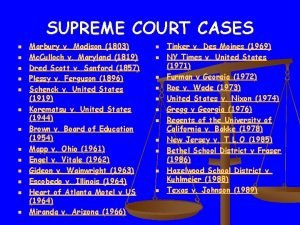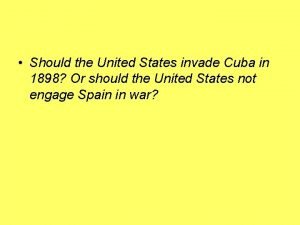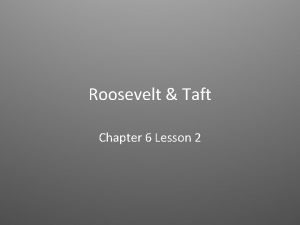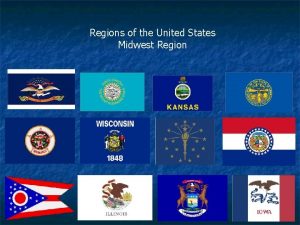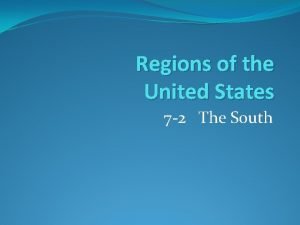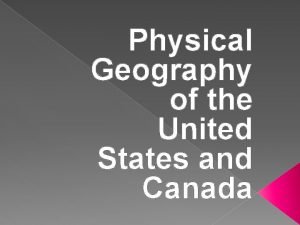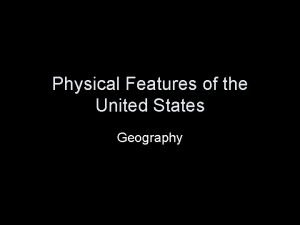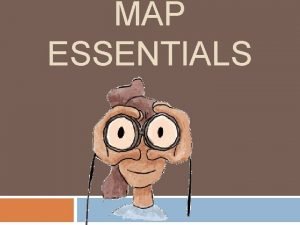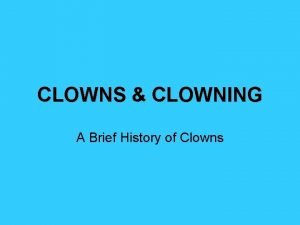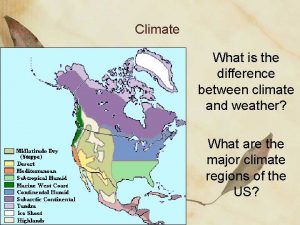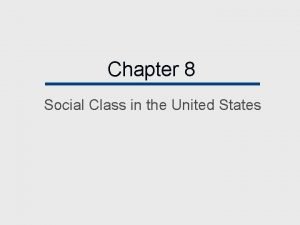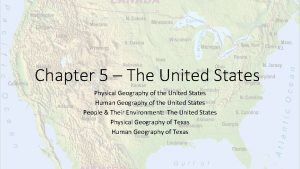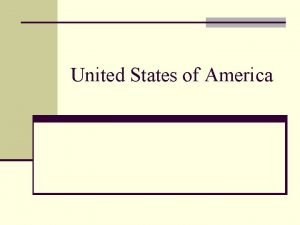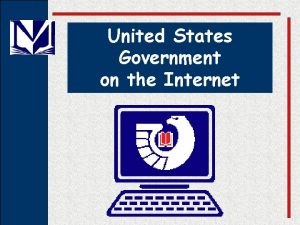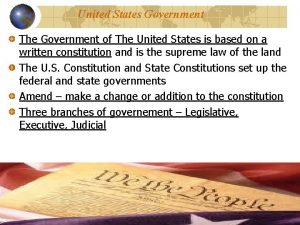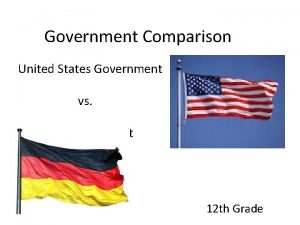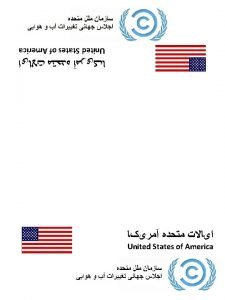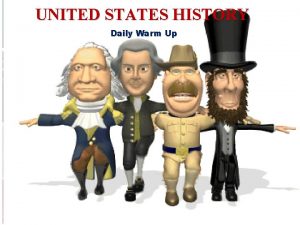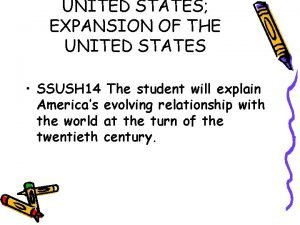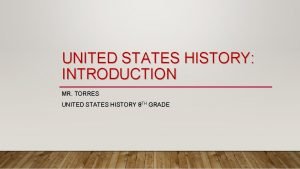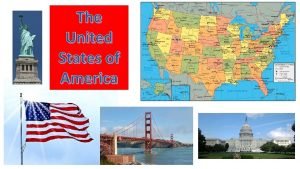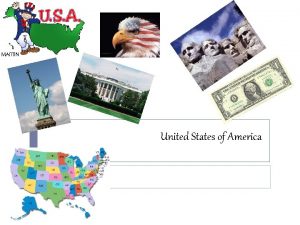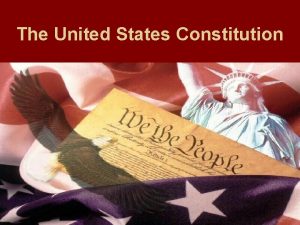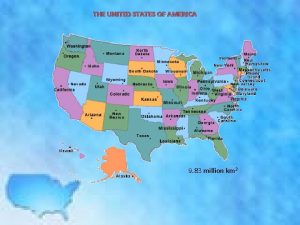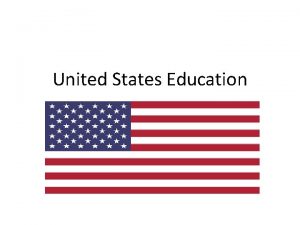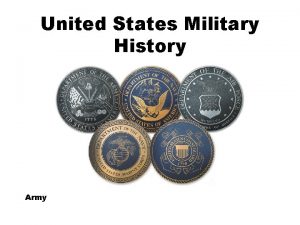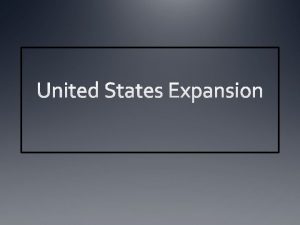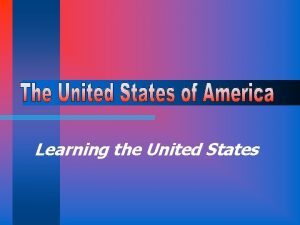The United States Government Chapter 3 Government Following





































- Slides: 37

The United States Government Chapter 3

Government Following the Revolutionary War • Following the Revolutionary War, thirteen independent states were left to figure out how to govern themselves. The colonists’ chief loyalty was to the state in which they lived. Each state established its own government based on English traditions and colonial experiences. Most state constitutions included a bill of rights that guaranteed certain important rights. These rights included freedom of the press, freedom of religion, and the right to trial by jury.

Foundations of the United States Government • Many policies, governmental procedures, and people influenced the formation of the new government of the United States. The following are the main influences: • The Magna Carta(1215) was a written document protecting the rights of English nobles. Although it didn’t protect the rights of the common man, it set the precedent that a king’s power was not absolute. • John Locke(1632 -1704) was an English philosopher who believed that government should derive its power from the people whom it governed. • Jacques Rousseau(1712 -1778) was a French philosopher who wrote The Social Contract in 1762. He believed that the right to rule should come from the people and not a king. The Social Contract Theory expressed the idea that there should be an agreement between the people and the government that limits the rights and duties of each. Thomas Jefferson(1743 -1826) agreed with this theory, and it became one of the philosophies for colonial separation from England expressed in the Declaration of Independence(1776).

• Baron de Montesquieu(1689 -1755) published The Spirit of the Laws in 1748. In this book, he expressed that government should possess legislative, executive, and judicial authority. In other words, government must make, enforce, and interpret the laws of the land. He thought the functions should be divided among three branches of government and that powers and duties should be carefully defined and separated so no branch acquired too much power. • The Great Awakening, a general revival of evangelical Christianity in the American colonies, reached its peak in the early 1740 s. This intercolonial movement contributed to a sense of American nationality before the Revolution. • The challenging life on the frontier taught the colonists the values of independence and self-reliance.

• Freedom of religion was a factor that shaped the United States government. Many people came to the thirteen colonies seeking freedom from religious persecution. For example, Puritans settled in Massachusetts, and Catholics settled in Maryland. • The House of Burgesses, the first colonial assembly, was established on July 30, 1619 in Jamestown to represent the colonies in the state of Virginia. Assemblies such as the House of Burgesses symbolized the authority of the people to limit the power of the king. This event was critical in developing state and national governments in the United States.

• The First and Second Continental Congresses (1774 -1781) brought together delegates from each of the thirteen colonies except Georgia. The First Continental Congress was the first time state representatives met together. These congressional meetings were a model forming the Unites States government. • The Declaration of Independence(1776) established general principles of human rights. It stated that people were “endowed by their Creator with certain unalienable rights” and that “among these are life, liberty, and the pursuit of happiness. ” This document laid a foundation for the United States government to establish equal rights for all people.

Articles of Confederation • Following the Declaration of Independence(July 4, 1776), the Second Continental Congress appointed a committee to draft a national constitution. This first constitution was called the Articles of Confederation. It was ratified, or approved, by all thirteen colonies in March, 1781, before the Revolutionary War ended that year. • The Articles of Confederation proposed an alliance between the thirteen independent states. A congress much like the Continental Congress made up the central government.

The following summarizes the powers of the national government under the Articles of Confederation: Gave Congress the power to • Declare war and make peace • Make foreign treaties and alliances • Coin and borrow money • Regulate weights and measures • Establish a post office • Regulate Indian affairs • Pass laws by 9 of the 13 states • Make amendments only with a unanimous vote of all states Prevented Congress from • Levying taxes • Regulating foreign or domestic trade • Settling disputes among states • Collecting state debts owed to the central government • Enforcing any of its powers

The Articles of Confederation had few strengths and many weaknesses. • Strengths: • States retained rights. The Articles guaranteed that each state would retain its “sovereignty, freedom, and independence” and keep “every power, jurisdiction, and right” not given directly to Congress. This clause for reserved powers protected states’ rights and made it more likely that state legislature would ratify the Articles of Confederation. The Articles, while weak, did signify the desire of the states to work for unity. • The central government established a post office. This development helped increase communication among the states.

Weaknesses • Loose bonds developed between independent states. States became more independent and put less emphasis on sending delegates to represent them in Congress. The loose bonds that held that states together as a confederation began to break. Since the central government could not settle disputes between states, the states operated like small, weak nations. Taking advantage of the disputes, Spain and Great Britain began taking land claimed by the Confederation. • One vote in Congress was given to each state. States had equal representatives regardless of size. Larger states opposed this idea because they insisted that states with more people should have more influence. Smaller states supported equal representation because it gave them equal power. All states eventually agreed to equal representation. They felt an urgent need for a national government to face foreign aggressors.

• There was no executive or judicial power. The Articles of Confederation made no provision for a chief executive officer or a national court system. Only the states had executive and judicial powers. As a result, the central government could not enforce any law that it passed, and it had no way of interpreting the law. Without executive or judicial powers, the central government had no real power. • Amendments required a unanimous vote. All states had to approve any changes made to the Articles of Confederation. This requirement made any real changes impossible.

The Constitutional Convention • It became clear by the spring of 1787 that the Articles of Confederation needed to be changed if the United States of America was going to survive as a nation. Congress called on the thirteen states to send delegates to Philadelphia to revise the Articles of Confederation. Twelve states sent a total of 55 delegates. Only Rhode Island failed to send representative. The convention in Philadelphia was called the Constitutional Convention(1787). • The delegates still feared that a strong central government would compromise state power, but they knew that the central government must have more power than given under the Articles of Confederation. They agreed that this new central government must have power to raise taxes, enforce laws, and provide a national defense. They wanted a republic in which the citizens would elect representatives to make and enforce laws. They also wanted a written constitution that spelled out the powers of the government. However, writing this constitution took long hours of debate and compromise.

• The Virginia delegates presented a plan for the new government. Under the Virginia Plan, representation in Congress would be based on a state’s population. This plan satisfied states with large populations, but angered small states who would have less representation. • Delegates from New Jersey made their own proposal. In the New Jersey Plan, each state would have an equal voice in Congress. This proposal satisfied the smaller states, who wanted representation equal to larger states. However, the larger states were upset by this proposal, feeling that this proposed Congress would not reflect the nation’s population.

• After much debate, the delegates arrived at the Great Compromise which divided Congress into two houses. In the upper house, the Senate, each state was represented by two senators. In the lower house, the House of Representatives, each state had representatives in proportion to its population. • The Great Compromise led to another question: How should slaves in the Southern states be counted in the population? Northern states said slaves should not be counted in the population since they were considered property. Southern states wanted them to be counted in the population in order to increase their representation in the House of Representatives. As a compromise between free and slave states in the House of Representatives, it was agreed that each slave counted as 3/5 of a person. For example, if a state had 5, 000 slaves, they would count as 3, 000 people in the state’s population count. This policy set a precedent that the government believed a black slave was worth only 3/5 of any other person.

• Another conflict between northern and southern states was the issue of slave trade with Africa. The northern states wanted to abolish slave trade, but the southern states insisted that it was a vital part of the southern economy. To compromise, Congress agreed not to interfere with the slave trade for 20 years. • To keep harmony between northern and southern states, delegates also agreed to prohibit export taxes and to require a two-thirds majority vote in the Senate to pass any treaty. These agreements kept the northern and the southern states from passing taxes or treaties that would be harmful to another region.

United States Government Under the Constitution • After many compromises, the delegates of the Constitutional Convention wrote the United States Constitution(1789). The Constitution spreads the power between the national government and state governments. (Local governments are set up by the states. ) The Constitution gives some powers to the national government, lets some power stay with the state governments, and lets both share some powers. This practice of dividing power is called federalism. Federalism keeps any one of the governments from gaining too much control. This system allows the people to have some power over the federal government at the state or local level.

• Constitutionalism refers to a government in which power is divided among various groups, but all groups obey a system of laws called a Constitution. • The United States has three branches of government: the executive, the legislative, and the judicial. The Constitution divides the powers among these three branches, so one group will not have too much power. For example, the Congress can declare war, but the President commands the soldiers. The writers of the Constitution made a separate branch of government for each function or purpose of national government.


• The writers of the Constitution knew that the limits of the powers and responsibilities of each branch were not always clear. To keep the branches equal in power, the writers developed a system of checks and balances. These checks and balances include the following elements: • The President can choose cabinet members, federal judges, and ambassadors, but the Senate must give advice and can approve or reject the President’s Choice. • The Congress can pass a bill, but the President can veto it, preventing it from becoming law • The President can make treaties with other countries, but the Senate must give advice and can approve or reject these treaties. • The Congress can pass a bill, and the President can sign it into law, but the Supreme Court can interpret the law in a way different from what the Congress intended. • This system of checks and balances slows the process of making decisions and taking action. The system is good because it gives American citizens time to learn about the issues and to give their opinions. It also gives the government time to think about the effects of any new law.

The Constitution includes a Preamble followed by Articles that describe how the federal government will function. • The Preamble states the purpose of establishing a new government under the Constitution. The Preamble does not establish any law. • Article 1 establishes the Legislative Branch, the branch of the federal government which makes the laws. This branch consists of a two-house Congress. The two houses are the Senate and the House of Representatives. Section 8, Clause 18 of Article 1 is known as the Elastic Clause. The Elastic Clause gives Congress the power to pass legislation that is “necessary and proper” for doing its job. It allows Congress to stretch the meaning of its delegated powers outlined in Section 8, Clauses 1 -17.

• Article 2 outlines the Executive Branch. It gives executive power to the President of the United States who is responsible for enforcing the laws passed by Congress. • Article 3 explains the Judicial Branch. The judicial branch of the federal government is the federal court system. The Constitution establishes the Supreme Court which is responsible for interpreting the laws made by Congress. • Article 4 gives the Relations Among the States and Between the States Federal Government. It ensures that each state recognizes the acts of other states. For example, a state must recognize a marriage license issued by another state.

• Article 5 provides for amendments to the Constitution. • Article 6 covers other miscellaneous provisions like prior public debts, supreme law of the land, and oaths the support the Constitution. • Article 7 explains ratification of the Constitution. Ratification of 9 out of the original 13 states would establish the Constitution as law in those states.

Ratifying the Constitution The delegates of the Constitutional Convention were mostly pleased with the government described by the United States Constitution. However, before the Constitution became law, it had to be ratified, or approved, by the states. • Supporters of the Constitution were called Federalists. • Federalists believed that the United States needed to have a strong national government. • They recognized the weaknesses of the Articles of Confederation where individual states could reject national policy. • Many prominent federalists such as James Madison, Alexander Hamilton, and John Jay wrote a series of newspaper articles that became known as the Federalist Papers. These influential articles stated the advantages of a federal union under the Constitution. They were written to persuade the people of New York State to support the Constitution. The Federalist Papers are crucial to a discussion of the political theory behind the United States government.

Opponents of the Constitution were known as Anti. Federalists. • Anti-federalists thought the new national government would be too powerful and that the states should not retain more power. • They believed the method of electing the President and the Senate was too far removed from the people. • They opposed the longer terms of office outlined in the Constitution because longer terms of office might take representatives less responsive to the voters. • Most importantly, anti-federalists argued that the Constitution lacked a specific bill of rights that protected individual liberties. • Despite opposition, all states eventually ratified the Constitution in 1788.

Amending the Constitution • Changes in the Constitution can be made through amendments. The writers of the Constitution recognized the nee to amend the document in order to keep the government flexible and current as circumstances changed. Proposing an amendment to the Constitution requires a two-thirds majority vote in Congress or a special convention called by two thirds of the state legislatures. The amendment must then be ratified by the legislatures of ¾ of the states or by a special convention.

The Bill of Rights • Once the Constitution was ratified, Congress began working on changes to the Constitution to insure individual rights. Congress wrote the ten amendments to the Constitution to insure basic rights and freedoms for American citizens. The first ten amendments are called the Bill of Rights.


• • Other Important Amendments to the Constitution 13 th Amendment(1865)- Slavery is abolished in the United States and its territories. 14 th Amendment(1868)- The Civil Rights of all people born or naturalized in the United States are guaranteed. 15 th Amendment(1870)- All male citizens have the right to vote regardless of race or color. 19 th Amendment(1920)- Women are guaranteed the right to vote.

The First Government Under the Constitution • The electoral college(a group of people representing each state) elected George Washington as the first President(1789 -1797). President Washington appointed Thomas Jefferson, author of the Declaration of Independence, as Secretary of State, and Alexander Hamilton, as Secretary of the Treasury. James Madison was a leader in the House of Representatives. Hamilton’s goal was to build a strong economy, but he met with opposition in fulfilling his goals, especially from Madison.

Politics and Policies in the New Government Hamilton’s Proposal • Hamilton favored paying the United States war debt in full. Speculators had purchased war bonds at a fraction of their cost from other citizens, and Hamilton thought that bonds held by speculators should be paid off at full price. He recognized that many speculators were wealthy individuals who supported the government through hard times and whom the nation would depend on for future credit. • Hamilton proposed that the federal government take over the states’ debt from the Revolutionary War. He felt this action would equalize the financial burden of the war and would strengthen national unity. • Hamilton wanted to create a national bank. He felt that the federal government had the power to create a bank under the Elastic Clause in the Constitution which gives Congress the power to pass legislation “necessary and proper” to carrying out its responsibilities. Since the United States government had the power to tax, Hamilton felt it must also have the power to form a national bank to receive those taxes. Hamilton favored a loose interpretation of the Constitution. He felt that the government had more powers than were actually listed in the Constitution.

Politics and Policies in the New Government Opposition • James Madison disagreed with Hamilton. He thought that the bonds held by speculators should be paid off at a reduced price since they had already made a profit by purchasing them for pennies on the dollar. Also, four-fifths of the national debt was owed to northern investors and speculators. Full funding of the bonds would seem to reward the North at the expense of the South. • Jefferson and Madison opposed Hamilton’s proposal. Citizens from the states that had already paid off their debt did not want to be taxed to pay the debts of other states. • Jefferson argued that a national bank was unconstitutional because the Constitution did not specifically authorize it. Jefferson’s interpretation of the Constitution was known as strict interpretation. He cited the 10 th amendment which stated that powers not delegated to the federal government are reserved to the states or to the people. His literal interpretation of the Constitution meant that the national government only had the powers specifically listed in the Constitution.

Politics and Policies in the New Government Result • Congress passed Hamilton’s proposal. Some members of Congress were probably influenced by their own speculation in war bonds. They would make a profit if the war bonds were paid off in full. • Hamilton, Jefferson, and Madison worked out a compromise that was approved by Congress. Since southern states owed less debt than northern states, Hamilton agreed to move the nation’s capital from New York in the North to Washington, D. C. in the South. Since having the capital in the south offered commercial advantages, the southern states agreed to fund the national debt and have the federal government assume state war debt. • Hamilton’s arguments won. Congress passed a bill creating a national bank, and President Washington signed the bill into law.

Washington’s Farewell Address When President Washington left office in 1797, after serving as President for eight years, he gave a farewell address which provided wise advice on several subjects. • He emphasized that the United States should stay neutral and avoid permanent alliances with other nations. • He spoke about the dangers of forming political parties. He warned that political parties would cause people to work for their special interests rather than for the public good, just as members of these parties had done in Great Britain. • He believed that good government is based on religion and morality.

Formation of Parties Despite Washington’s warnings, political parties arose in the United States quickly after he left office. Alexander Hamilton led one party supporting a strong federal government. They called themselves the Federalists. Thomas Jefferson led the opposing party supporting strong state governments. They called themselves Democratic-Republicans. Political parties helped people to unite on common issues.

Opposing Views of Hamilton and Jefferson Federalists • Favored a strong federal government • Wanted power in the hands of the wealthy and welleducated rather than in the hands of the people • Thought the nation’s economy should be based on manufacturing, shipping, and commerce and not on farming • Interpreted the Constitution loosely as giving powers not specifically stated Democratic-Republicans • Favored states retaining authority • Wanted power in the hands of the people because they felt the people were the safest store of power • Thought the nation’s economy should be based on agriculture • Interpreted the Constitution strictly as giving powers only as stated

• John Adams, a Federalist, became the second President of the United States in 1797. Adams appointed John Marshall, also a Federalist, as the Chief Justice of ht Supreme Court. Marshall became one of the most influential people to hold office. He established the supremacy of the national government over the states. His decisions showed that the Constitution could adapt to the changing size and needs of the nation.

• In the court case, Marbury vs. Madison (1803), John Marshall established the Supreme Court’s right of Judicial Review. The court now had the right to declare whether laws passed by Congress were constitutional or not. • In the case of Gibbons vs. Ogden (1824), the Supreme Court ruled that Congress alone had the power to regulate interstate a foreign commerce. This decision allowed the building of roads and canals to increase without the restrictions of state monopolies. • In other court cases, Marshall upheld the sanctity of contracts and established the right of the Supreme Court to declare state law unconstitutional.
 United states government: principles in practice solutions
United states government: principles in practice solutions Us history regents essay
Us history regents essay Chapter 2 free enterprise in the united states answer key
Chapter 2 free enterprise in the united states answer key Why is the united states called a postindustrial economy
Why is the united states called a postindustrial economy What states are west of the mississippi river
What states are west of the mississippi river Was the united states on the axis powers or allied powers?
Was the united states on the axis powers or allied powers? Many _____ people have settled in this megalopolis.
Many _____ people have settled in this megalopolis. Sectionalism map of the united states
Sectionalism map of the united states United states soccer league system
United states soccer league system Marshall case
Marshall case United states student association
United states student association The united states ought to provide a universal basic income
The united states ought to provide a universal basic income Preamble
Preamble The united states in the caribbean 1776-1985
The united states in the caribbean 1776-1985 What is the southeast region of the united states
What is the southeast region of the united states Expansion of the united states of america 1607 to 1853 map
Expansion of the united states of america 1607 to 1853 map How did nicholas novikov describe the united states
How did nicholas novikov describe the united states Previous owner of oregon country
Previous owner of oregon country Awake united states
Awake united states Mapp v ohio
Mapp v ohio Why did the united states invade cuba in 1898?
Why did the united states invade cuba in 1898? Guided reading activity lesson 2 roosevelt and taft
Guided reading activity lesson 2 roosevelt and taft Midwest region of the united states
Midwest region of the united states 7 regions of the united states
7 regions of the united states The united states is the greatest buyer positive degree
The united states is the greatest buyer positive degree United states and canada physical map
United states and canada physical map What are the major physical features of the united states
What are the major physical features of the united states Map of world with longitude and latitude lines
Map of world with longitude and latitude lines North south east west in our calm objective opinion
North south east west in our calm objective opinion North central america
North central america The history of clowns
The history of clowns Subtropical united states
Subtropical united states Consequences of social class
Consequences of social class Physical geography of the united states
Physical geography of the united states Ibn-tamas v. united states
Ibn-tamas v. united states Mr pirzada
Mr pirzada What is the geographical position of the united states
What is the geographical position of the united states United states lactation consultant association
United states lactation consultant association
